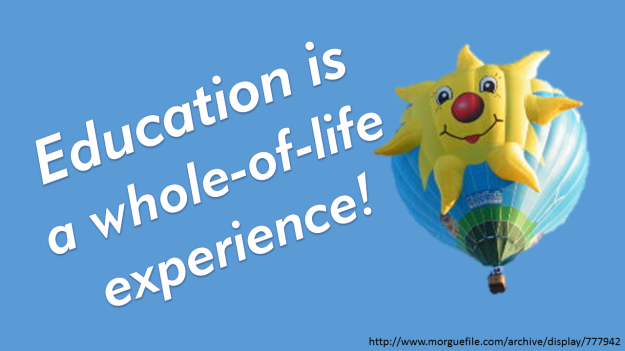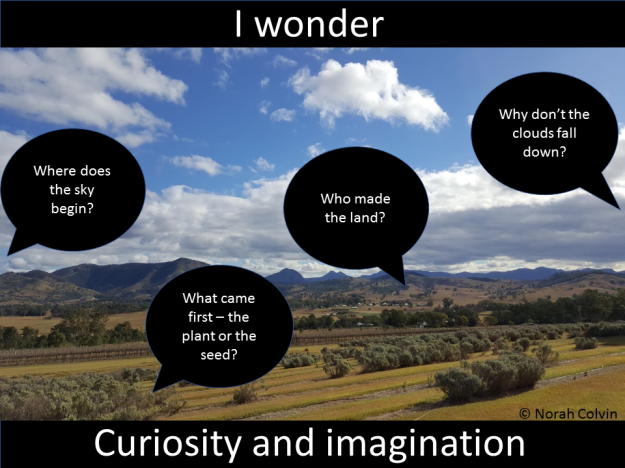
© Norah Colvin
My mother used to sometimes say that she didn’t know whether she was coming or going, meaning that she was a bit frazzled with too much to do and too little time. With a small house filled ten children, is it any wonder?
Sometimes when asked “How are you going?” meaning “How are you going in life?” or simply, “How are you?” people respond, “Getting there”. Sometimes I wonder where they are getting, and wonder if they know too.
But does it matter? Is it important to know where we are getting? Is not there joy in the journey itself? What if the “there” turns out to be totally unexpected, a surprise? I have no idea where I’ll be after the door on this life’s journey closes. I hope it’s a pleasant surprise, but I’m more inclined to think it will be no surprise at all. This convinces me that it is important to enjoy the journey whether we’re coming or going or anywhere in between.

One of the purposes of education is to support people along their life’s journey, regardless of where they came from or where they are going. I previously wrote about some issues affecting itinerant families in This too will pass. Saying goodbye to friends, if indeed there has been time to establish friendships can be difficult; so too the establishment of new friendships at each next place.
Robbie Cheadle, who blogs at Robbie’s Inspiration, recently shared her experiences in a comment on the readilearn blog. She said, “I changed schools 14 times during my primary school years and it was very hard. I was always the new girl and always having to start over. It does teach you to get on with people and to be resilient.” Robbie obviously learned to do so, but it doesn’t happen that way for all.
Sherri Matthews, another friend from the S.M.A.G. community, who blogs at A View from my Summerhouse recently shared her excitement at the publication of her essay Promise of a Rose Garden in Lady by the River: Stories of Perseverance, “a collection of personal stories about facing everyday challenges”. This is a wonderful book and I have no hesitation in recommending it to you.
In her moving story, Sherri describes “having her heart ripped out” at ten years of age when she realises that the goodbyes exchanged between herself and her father as she left for school were more permanent than she expected. She says she kept her feelings inside, telling no one how she felt about her mother leaving her father. She says, “I cried alone at night, missing my dad so much that I thought my heart would break”.
These two experiences alone demonstrate that we may never know just what the children in our classrooms are experiencing. They may keep their feelings inside, not wanting to share. This is particularly so when the time that could be used for getting to know each other is pushed out to accommodate more drill and practice and standardised testing.
No child’s situation is the same as any other. There is no standard experience that puts everyone in the same spot on the graph at the same time. We need to make the effort to get to know individuals and to tailor the situation to their needs. This means providing opportunities for them to share their experiences, discuss their feelings, and follow their interests.
Of course, children should never be pressured to share more than they are comfortable with, but an open, welcoming, supportive classroom will provide them with a refuge from other issues that may confront them. I seem to keep returning to this point: the importance of a warm, welcoming, supportive classroom. I’m like a broken record, stuck in that groove. But it is the relationships that are vital and of greatest influence to a child’s ability to learn.
There are many simple activities which can be incorporated into the school day to help build community. I’ve talked before about the way I used to do the roll, with each child standing in turn to greet classmates. How much more effective it may have been had children said “good morning” in their mother tongue, teaching others the greeting, and receiving it in response. Children enjoy learning words from other languages. What a great celebration of diversity this would be.
It was these thoughts that went around and around in my head this week when Charli Mills of the Carrot Ranch challenged writers to In 99 words (no more, no less) write a hello or a goodbye. You can pick any greeting that grabs you from howdy to fare thee well. It will be interesting to see how the collection intertwines the opposite greetings. Charli herself has experienced a series of hellos and goodbyes in recent times, with another goodbye imminent.
For my goodbye story, I have taken another turn and gone full circle. I hope you like it.
Round and round
He felt tall, grown up, sitting in the saddle, holding the reins, feet in the stirrups.
Mum was watching.
“Hold tight,” she whispered. “Love you.”
He smiled. Then they were off. He turned, letting go quickly to wave one hand.
“Goodbye,” he called. His lip quivered. How soon before he’d see her again? He turned, but she’d disappeared.
Suddenly she was in front of him.
“Hello,” she called.
“Hello,” he smiled.
Again, she was gone. “Goodbye,” he heard; then “Hello again!” He giggled.
“Going around in circles,” she thought. “Life’s like a carousel. You’ve got to enjoy the ride.”

Thank you for reading. I appreciate your feedback. Please share your thoughts.




















